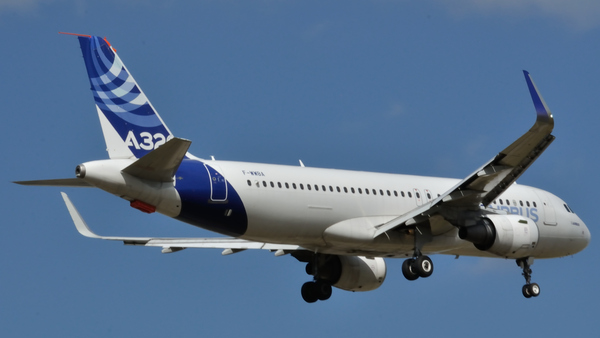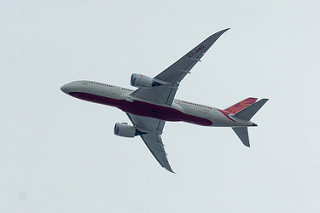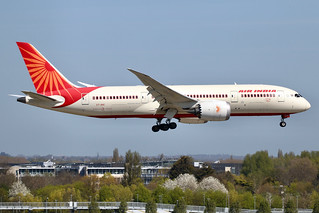India A320 at Kolkata and Nagpur on Jul 22nd 2017, "inexplicable" performance degradation
Last Update: December 16, 2020 / 14:24:04 GMT/Zulu time
Incident Facts
Date of incident
Jul 22, 2017
Classification
Incident
Airline
Air India
Flight number
AI-676
Departure
Kolkata, India
Destination
Mumbai, India
Aircraft Registration
VT-EXE
Aircraft Type
Airbus A320
ICAO Type Designator
A320
The aircraft remained on the ground in Nagpur for about 2 hours, then departed again, achieved normal climb performance, climbed to cruise level FL360 and landed safely in Mumbai with a delay of 3:45 hours.
On Jul 25th 2017 the airline reported both pilots were de-rostered due to not retracting the landing gear after departure from Kolkata and continuing to fly without detecting that the landing gear was still extended despite the unusually poor performance. The occurrence is being investigated by the airline.
On Dec 2nd 2020 India's DGCA announced the release of the final report into the occurrence, however, attached the final report of VT-ESE of Oct 4th 2017 (Report: India A320 at Surat on Oct 4th 2017, overran end of runway) with their announcement labelled: "Final Investigation Report on Incident of Flight with Extended Landing Gear to M/s Air India, A-320 aircraft VT-EXE on 22.07.2017 enroute Kolkata -Nagpur."
On Dec 16th 2020 India's DGCA corrected the link posted on Dec 2nd 2020 now linking the correct final report concluding the probable cause of the incident was:
The incident of ‘flight with extended landing gear’ occurred due non-adherence to ‘standard operting procedure’ on the part of both the flight crew after take-off.
The DGCA reported the captain (34, ATPL) had accumulated 5,991 hours total flying hours and was pilot flying, the first officer (28, CPL) had accumulated 446 hours on type and was pilot monitoring, and summarized the sequence of events:
The aircraft took-off from Kolkata at 0433 UTC. The flight crew carried out the mandatory “after take-off checklist” and continued to destination. The flight crew deviated from the flight path to avoid weather, with due approval of the Kolkata ATC. The ‘engine anti-ice’ and ‘wing anti-ice’ system were switched ON due flight through icing conditions.
The flight crew was unable to achieve climb to the planned altitude enroute and also the planned speed. The flight crew then re-programmed the flight plan in to FMS to solve the problem, but it remained unsolved. Then the flight crew had turned OFF the anti-ice system in anticipation to improve the climb performance and speed, however this did not improve the performance. The flight crew did not receive any warning or caution messages from the Electronic Centralised Aircraft Monitoring (ECAM) system.
After an hour into the flight, the flight crew observed that the fuel quantity remaining on arrival at destination was below the planned fuel, which would result in insufficient fuel at destination. The flight crew then decided to divert. Bhubaneswar was the planned alternate airport for diversion. As it was raining in Bhubaneswar as well as in Kolkata; the flight crew decided to divert to Nagpur. The flight crew requested Kolkata ATC to inform Nagpur ATC about their diversion to Nagpur.
The aircraft arrived over Nagpur. The flight crew began to carry out ‘approach’ check list. While configuring the aircraft during the approach checks, the flight crew realized that landing gears were in extended position and were not retracted after take-off from Kolkata. The aircraft landed safely at Nagpur at 0631 UTC. The flight crew reported in PDR that the reason for diversion was insufficient fuel. The AME carried out inspection for fuel leak. There was no fuel leak and no abnormality detected in the aircraft. The aircraft was refuelled and released for onward flight to Mumbai. The aircraft landed safely at Mumbai airport.
The DGCA analysed that there was no technical problem prior to departure for the flight, in flight all systems also worked as designed, the airspeed never exceeded 280 KIAS, the maximum speed for gear down. Maintenance thus was not a factor into the occurrence.
The DGCA continued analysis:
For this sector, pilot-in-command was the pilot flying (PF) and the first officer was the pilot monitoring (PM). The task sharing is such that PF will fly and navigate and the PM will monitor and communicate. Apart from this, the QRH checklist clearly distributes the cockpit checklist procedures between PF and PM. Soon after take–off from Kolkata, on achieving ‘positive climb’ the pilot- in- command ordered for selecting landing gear up. It was the task of the first officer to select the landing gear up. But she did not do so. It was an omission on the part of the first officer. Further, the first officer checked only one item ‘BARO’ in the ‘After Take-off’ checklist and did not check the rest three items which included retracting of ‘landing gear’. This was again another omission on the part of the first officer. The pilot-in-command mentioned that the incident probably could have been averted had she cross-checked the ‘After Take-off’ check list by actually looking at parameters. It was her duty to cross-check or verify following a ‘challenge and response’ procedure. But the pilot-in-command did not verify when the first officer was carrying out the ‘After Take-Off Check list’. This was an omission on the part of the pilot-in-command. During approach at Nagpur when the aircraft was at 500 feet and not stabilized, the first officer did not give a call ‘NOT STABILIZED, GO AROUND. This was also an omission on the part of the first officer. But this did not contribute to the incident. Thus, it is clear that the landing gear was not retracted because both the flight crew did not carry out the ‘After Take-off’ checklist following a ‘challenge and response’ procedure. There were series of omissions by both the flight crew. After landing at Nagpur, the fact that the aircraft had flown with landing gear down was not mentioned in ‘Pilot Defect Report’. It was a significant occurrence. A mention of the same in PDR was necessary for structural inspection. It appears that there was an attempt on the part of the pilot-in-command to hide the occurrence. Hiding such significant occurrence could be hazardous to operational safety of aircraft. Maximum speed limit with the landing gear extended (VLE) is 280 kt. The maximum speed reached during the flight was 232.9 kt. The speed limit was not exceeded. There is no mention of altitude restriction with regard to landing gear in extended position. The landing gear remained extended in flight from Kolkata to Nagpur and there was continuous ‘three greens’ indication in cockpit. But it did not occur to the flight crew that ‘three greens’ indication should not be there in a flight during cruise. Both the flight crew did not adhere to ‘standard operating procedure’ after take-off from Kolkata. They did not carry out the ‘After Take-off check list’ following ‘challenge and response’ procedure properly. It was a causal factor to the incident.
Incident Facts
Date of incident
Jul 22, 2017
Classification
Incident
Airline
Air India
Flight number
AI-676
Departure
Kolkata, India
Destination
Mumbai, India
Aircraft Registration
VT-EXE
Aircraft Type
Airbus A320
ICAO Type Designator
A320
This article is published under license from Avherald.com. © of text by Avherald.com.
Article source
You can read 2 more free articles without a subscription.
Subscribe now and continue reading without any limits!
Read unlimited articles and receive our daily update briefing. Gain better insights into what is happening in commercial aviation safety.
Send tip
Support AeroInside by sending a small tip amount.
Related articles
India A320 at Kathmandu on Nov 25th 2023, suspected tail strike
An Air India Airbus A320-200, registration VT-EXE performing flight AI-216 from Kathmandu (Nepal) to Delhi (India), was departing Kathmandu's runway…
India B788 at Ahmedabad on Jun 12th 2025, lost height shortly after takeoff, no thrust reported
An Air India Boeing 787-8, registration VT-ANB performing flight AI-171 from Ahmedabad (India) to London Gatwick,EN (UK) with 230 passengers and 12…
India A20N near Bhopal on Nov 3rd 2025, cargo smoke indication
An Air India Airbus A320-200N, registration VT-EXO performing flight AI-2487 from Delhi to Bangalore (India) with 172 people on board, was enroute at…
India B773 near Ulaanbaatar on Nov 3rd 2025, technical issue
An Air India Boeing 777-300, registration VT-AEH performing flight AI-174 (dep Nov 2nd) from San Francisco,CA (USA) to Kolkata (India), was enroute…
India B788 at Birmingham on Oct 4th 2025, RAT deployed
An Air India Boeing 787-8, registration VT-ANO performing flight AI-117 from Amritsar (India) to Birmingham,EN (UK), was on final approach to…
India B788 near Dubai on Oct 9th 2025, multiple system failures
An Air India Boeing 787-8, registration VT-ANC performing flight AI-154 from Vienna (Austria) to Delhi (India), was enroute at FL390 about 310nm…
Newest articles
Eastern Airways AT72 at Newquay on Apr 15th 2025, flaps problems
An Eastern Airways Avions de Transport Regional ATR-72-212A. registration G-IACZ performing flight T3-458 from London Gatwick,EN to Newquay,EN (UK),…
India B788 at Ahmedabad on Jun 12th 2025, lost height shortly after takeoff, no thrust reported
An Air India Boeing 787-8, registration VT-ANB performing flight AI-171 from Ahmedabad (India) to London Gatwick,EN (UK) with 230 passengers and 12…
Subscribe today
Are you researching aviation incidents? Get access to AeroInside Insights, unlimited read access and receive the daily newsletter.
Pick your plan and subscribePartner

ELITE Simulation Solutions is a leading global provider of Flight Simulation Training Devices, IFR training software as well as flight controls and related services. Find out more.
SafetyScan Pro provides streamlined access to thousands of aviation accident reports. Tailored for your safety management efforts. Book your demo today
AeroInside Blog
Popular aircraft
Airbus A320Boeing 737-800
Boeing 737-800 MAX
Popular airlines
American AirlinesUnited
Delta
Air Canada
Lufthansa
British Airways





